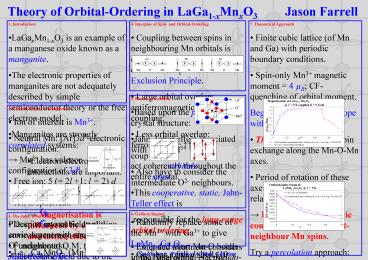Theory of Orbital-Ordering in LaGa1-xMnxO3 Jason Farrell - PowerPoint PPT Presentation
Title:
Theory of Orbital-Ordering in LaGa1-xMnxO3 Jason Farrell
Description:
Theory of Orbital-Ordering in LaGa1-xMnxO3 Jason Farrell 1. Introduction LaGaxMn1-xO3 is an example of a manganese oxide known as a manganite. – PowerPoint PPT presentation
Number of Views:59
Avg rating:3.0/5.0
Title: Theory of Orbital-Ordering in LaGa1-xMnxO3 Jason Farrell
1
Theory of Orbital-Ordering in LaGa1-xMnxO3
Jason Farrell
- 1. Introduction
- LaGaxMn1-xO3 is an example of a manganese oxide
known as a manganite. - The electronic properties of manganites are not
adequately described by simple semiconductor
theory or the free electron model. - Manganites are strongly correlated systems
- Electron-electron interactions are important.
- Electron-phonon coupling is also crucial.
- ? Magnetisation is influenced by electronic and
lattice effects. - La1-xCaxMnO3 (Mn3 and Mn4) and similar
mixed-valence manganites are extensively
researched. - These may exhibit colossal magnetoresistance
(CMR). - ? Very large change in resistance as a magnetic
field is applied. - ? Possible use in magnetic devices technological
importance. - BUT LaGaxMn1-xO3 (Mn3 only no CMR) has not
been extensively studied.
- 4. Interplay of Spin- and Orbital-Ordering
- Coupling between spins in neighbouring Mn
orbitals is determined by the amount of orbital
overlap ? Pauli Exclusion Principle. - Large orbital overlap antiferromagnetic ?? spin
coupling. - Less orbital overlap ferromagnetic ?? spin
coupling. - Also have to consider the intermediate O2-
neighbours. - Extended treatment considers virtual
interorbital electron hopping the
Goodenough-Kanamori-Anderson (GKA) rules. - Gives the same result also gives each exchange
constant.
- 7. Theoretical Approach
- Finite cubic lattice (of Mn and Ga) with
periodic boundary conditions. - Spin-only Mn3 magnetic moment 4 µB
CF-quenching of orbital moment. - Begin with LaGaO3 and dope with Mn3
- Theory ferromagnetic spin exchange along the
Mn-O-Mn axes. - Period of rotation of these axes is faster than
spin relaxation time. - ? Isotropic ferromagnetic coupling between
nearest-neighbour Mn spins. - Try a percolation approach
- As Mn content increases, ferromagnetic Mn
clusters will form. - At higher Mn content, larger clusters will form.
- At a critical Mn fraction, the percolation
threshold, xc, a supercluster will extend over
the entire lattice. - ? Determine the magnetisation per Mn3 as a
function of doping
(a)
(b)
(c)
Mn O Mn
Mn O Mn
Mn O Mn
- 5. Physics of LaMnO3
- Based upon the perovskite crystal structure
- Jahn-Teller effect associated with each Mn3
- act coherently throughout the entire crystal.
- This cooperative, static, Jahn-Teller effect is
- responsible for the long-range orbital ordering.
- Long and short Mn-O bonds in the basal plane ? a
pseudo-cubic crystal. - The spin-ordering is a consequence of the
orbital ordering (Section 4). - ? A-type spin ordering spins coupled
ferromagnetically in the xy plane
antiferromagnetic coupling along z. - Long-range magnetic order is (thermally)
destroyed above TN 140 K. - Long-range orbital order is more robust
destroyed above TJT 750 K. - ? Structural transition to cubic phase.
- On-site Coulomb repulsion U (4 eV) is greater
than electron bandwidth W (1 eV) ?LaMnO3 is a
Mott-Hubbard insulator.
Magnetisation of LaGa1-xMnxO3
_at_ T 5 K applied B 5 Tesla
- 2. General Physics of Manganites
- Ion of interest is Mn3.
- Neutral Mn Ar3d7 electronic configuration.
- ? Mn3 has valence configuration of 3d4.
- Free ion 5 ( 2l 1 l 2) d levels are wholly
degenerate. - Ion is spherical.
- Place ion into cubic crystal environment with six
Oxygen O2- neighbours - Electrostatic field due to the neighbours the
crystal field. - Stark Effect electric-field acting on ion.
- Some of the 5-fold degeneracy is lifted.
- Cubic crystal less symmetric than a spherical
ion. - ? d orbitals split into two bands eg and t2g.
- t2g are localised the eg orbitals are important
in bonding. - On-site Hund exchange, JH, dominates over the
crystal field splitting ?CF. - ? 4 spins are always parallel a high-spin ion.
M (µB/Mn)
x
Polycrystalline experimental data Vertruyen B.
et al., Cryst. Eng., 5 (2002) 299
20 x 20 x 20 percolation simulation
orbitals
spins
Orthorhombic Strain in
LaMn1-xGaxO3 _at_ T 5 K
20 x 20 x 20 Simulation
2(b-a)/(ba)
Experimental Data Vertruyen B. et al., Cryst.
Eng., 5 (2002) 299
t2g
eg
hello
- 6. Gallium Doping
- Randomly replace some of the Mn3 with Ga3 to
give LaMn1-xGaxO3. - Ga3 has a full d shell (10 electrons)
- ? Ion is diamagnetic (no magnetic moment)
- ? Not a Jahn-Teller ion GaO6 octahedra, unlike
MnO6, are not JT-distorted. - How does such Gallium-doping affect the orbital
ordering and hence the magnetic and structural
properties of the material?
- 3. The Jahn-Teller Effect
- Despite crystal field splitting, some degeneracy
remains. - Fundamental Q.M. theory the Jahn-Teller effect.
- Lift as much of the ground state degeneracy as
possible - ? Further splitting of the d orbitals
- Orbitals with lower energy preferential
occupation - ? JTE introduces orbital ordering.
- Lift degeneracy ? reduce symmetry.
- Strong electron-lattice coupling.
- ? Jahn-Teller effect distorts the ideal cubic
lattice.
x
- Supervisor Professor Gillian Gehring































